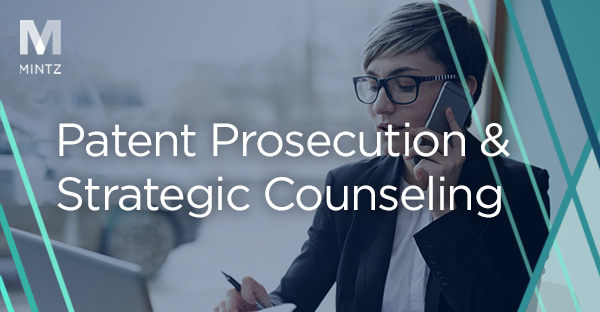
Intellectual Property
Viewpoints
Filter by:
ALJ Shaw Confirms ITC’s Post-Suprema Authority to Exclude Articles That Infringe After Importation Based on Contributory Infringement
August 10, 2015 | Blog | By Matthew Karambelas
The International Trade Commission has recently released the public version of the Administrative Law Judge’s Final Initial Determination in Certain Marine Sonar Imaging Devices, Including Downscan and Sidescan Devices, Products Containing the Same, and Components Thereof, Inv. No. 337-TA-921, Init Det. (July 2, 2015).
Read more
Expediting Patent Prosecution with the New Collaborative Search Pilot Program
August 7, 2015 | Blog | By Christina Sperry
Two new Collaboration Search Pilot Programs are or will soon be available to patent applicants. The Collaboration Search Pilot Program (CSP) between the United States Patent and Trademark Office (USPTO) and the Japan Patent Office (JPO) is available as of August 1, 2015.
Read more
USPTO Issues Newly Updated Guidance on Subject Matter Eligibility that Further Clarifies Examination Standards under 35 U.S.C. §101 in Light of Alice v. CLS Bank
August 4, 2015 | Alert | By Michael Van Loy
Over the past few years, the Supreme Court’s decisions in Alice (Alice Corp. v. CLS Bank Int’l, 134 S.Ct. 2347 (2014)) and Mayo (Mayo Collaborative Servs. v. Prometheus Labs., Inc., 132 S. Ct. 1289 (2012)), and other cases relating to subject matter eligibility under 35 U.S.C. § 101 have resulted in significant changes in how the United States Patent and Trademark Office (“USPTO”) examines patent applications.
Read more
Commil USA V. Cisco Systems: “I thought it was legal” is no defense to induced infringement under 35 U.S.C. § 271(b)
August 3, 2015 | Advisory | By Adam Samansky, Serge Subach
The United States Supreme Court’s recent decision in Commil v. Cisco held that a good-faith belief of a patent’s invalidity, standing alone, is insufficient to provide a defense to a claim of inducing another’s infringement of a United States Patent.
Read more
Federal Circuit Clarifies Standard for Prior Art in Obviousness Analysis
July 31, 2015 | Blog | By Nick Armington, William Meunier
Earlier this week, the Federal Circuit in Circuit Check Inc. v. QXQ, Inc. clarified the standard by which a reference may be considered prior art for the purposes of an obviousness determination.
Read more
FTC Commissioners Weigh in on FRAND Debate
July 27, 2015 | Alert | By Sandra Badin, Michael Renaud
Two weeks ago, Federal Trade Commission (FTC) Chairwoman Edith Ramirez, writing on her own behalf, submitted comments in Investigation No. 337-TA-613, Certain 3G Mobile Handsets and Components Thereof (the 613 Investigation) on how the International Trade Commission (ITC) should approach the adjudication of the FRAND defense when conducting the public interest analysis.
Read more
EU Court Clarifies the Conditions Under Which Assertion of Standard-Essential Patents May Constitute Abuse of Market Dominance
July 23, 2015 | Alert | By Sandra Badin, Bruce Sokler, Michael Renaud, Rich Gervase
Last week, in response to a request for a preliminary ruling by a German court hearing a patent infringement action brought by Huawei against ZTE, the Court of Justice of the European Union (ECJ) took up the question of whether the assertion of patents that have been declared essential to the practice of a standard (standard-essential patents or SEPs) may run afoul of Article 102 of the Treaty on the Functioning of the European Union (TFEU).
Read more
Biosimilars, the BPCIA, and Amgen v. Sandoz: The Federal Circuit’s First Attempt To Make Sense of “A Riddle Wrapped in a Mystery Inside an Enigma”
July 22, 2015 | Alert | By Thomas Wintner
On July 21, 2015, the Federal Circuit issued a key decision regarding the meaning of various provisions of the Biologics Price Competition and Innovation Act (BPCIA). See Amgen Inc. v. Sandoz Inc., Fed. Cir. Case No. 2015-1499.
Read more
PTAB Issues Representative Order Clarifying Motion to Amend Analysis in Idle Free Systems
July 21, 2015 | Blog | By Brad M Scheller
Yesterday the Patent Trial and Appeal Board (“Board”) added a recent order to its list of Representative Orders, Decisions, and Notices.
Read more
Writing on Her Own Behalf, Chairwoman Ramirez Takes a Position on FRAND
July 17, 2015 | Alert | By Michael Renaud, Sandra Badin, Robert Moore
Federal Trade Commission (FTC) Chairwoman Edith Ramirez took the unusual step on July 13, 2015, of filing a written submission on her own behalf — and expressly not on behalf of her agency — in Investigation No. 337-TA-613, Certain 3G Mobile Handsets and Components Thereof (the 613 Investigation).
Read more
ITC Sheds Light on Economic Prong of Domestic Industry Under Subsection 337(a)(3)(C) and Issues General Exclusion Order
July 6, 2015 | Blog
On June 26, 2015, the ITC handed down its Commission Opinion in Certain Loom Kits for Creating Linked Articles, Inv. No. 337-TA-923, Comm’n Op. (Feb. 3, 2015) (hereinafter “Loom Kits ”), granting a general exclusion order.
Read more
Federal Circuit Affirms Dismissal on Grounds of Patent Ineligibility
July 1, 2015 | Blog | By Michael Van Loy, Monique Winters Macek
On June 23, 2015, the Federal Circuit affirmed the finding of the U.S. District Court for the Northern District of California (“District Court”) dismissing the complaints in four related actions for infringement of U.S. Patent No. 7,707,505 (the ‘505 Patent) on the ground of patent ineligibility under 35 U.S.C. §101.
Read more
The Federal Circuit Alters the Means-Plus-Function Analysis
July 1, 2015 | Blog | By William Meunier
The Federal Circuit’s recent en banc opinion in Williamson v. Citrix Online, LLC, 2015 U.S. App. LEXIS 10082, *2 (Fed. Cir. June 16, 2015) (Williamson II) may result in courts finding that more claims include “means-plus-function” claim elements, which could significantly affect the scope and validity of those claims.
Read more
Crowdfunding and IP in Health and Biotech Start-ups (Part 3): Potential Dangers
June 29, 2015 | Blog | By Lisa Adams
PART III: First, the JOBS Act requires the SEC to issue complex implementing rules prior to crowdfunding becoming a reality. For any startup seeking funding through a crowdfunding source, the rules proposed by the SEC under the Act demand detailed disclosures regarding the company. The company must also describe exactly how the securities it is offering are being valued.
Read more
Crowdfunding and IP in Health and Biotech Start-ups (Part 2): The JOBS Act
June 25, 2015 | Blog | By Lisa Adams
PART 2: he US government began to address these investment challenges through the Jumpstart Our Business Startups Act (JOBS Act) in April 2012. While companies like Kickstarter allow startups to sell products or services, the JOBS Act envisions companies actually selling equity in themselves through crowdfunding campaigns.
Read more
Federal Circuit Invalidates Diagnostic Method Claims for Prenatal Test Under 35 U.S.C. 101
June 24, 2015 | Alert | By Terri Shieh-Newton
On June 12, 2015, the Federal Circuit affirmed the finding of U.S. District Court for the Northern District of California (“District Court”) that the method claims in U.S. Patent 6,258,540 (‘540 patent) for detecting paternally-inherited cell-free DNA (“cffDNA”) in maternal plasma or serum were not directed to patent eligible subject matter, and, therefore, were invalid.
Read more
Newsflash, Politico: 'Patent Death Squad' Alive and Well
June 24, 2015 | Blog | By Michael McNamara
Politico, the popular political journalism publication, recently ran the story “Patent Reform Advocates: PTO Process Not Patent ‘Death Squad.’” The story was based on a blog post by patent reform advocate Unified Patents.
Read more
Supreme Court Upholds Brulotte Rule Prohibiting Post-Expiration Patent Royalties
June 23, 2015 | Alert | By Bruce Sokler, Sandra Badin, Rich Gervase
On June 22, 2015, the Supreme Court issued its decision in Kimble v. Marvel Entertainment, LLC, upholding the rule, first announced in Brulotte v. Thys Co., 379 U. S. 29 (1964), that an agreement allowing a patent owner to collect royalty payments after a patent’s expiration is unlawful per se.
Read more
Fed Circuit Reverses PTAB Decision in IPR Proceeding
June 22, 2015 | Blog | By Arun K. Goel, Brad M Scheller
On June 16, the Federal Circuit issued its first-ever reversal of a Patent Trial and Appeal Board decision in an America Invents Act post-grant proceeding. The opinion, drafted by Chief Judge Prost and joined by CAFC Judge Lourie and E.D. Tex. Judge Gilstrap, provides considerable guidance on claim construction and claim amendments in practice before the PTAB.
Read more
New USPTO Expedited Patent Appeal Pilot Program
June 19, 2015 | Blog | By Christina Sperry, Brad M Scheller
On June 15, 2015, the United States Patent and Trademark Office (“USPTO”) issued Notice in the Federal Register announcing a new pilot program, the Expedited Patent Appeal Pilot.
Read more
Explore Other Viewpoints:
- Data Centers & Digital Infrastructure
- AI: The Washington Report
- Antitrust and Federal Regulation
- Appellate
- Arbitration, Mediation & Alternate Dispute Resolution
- Artificial Intelligence
- Awards
- Bankruptcy & Restructuring
- California Land Use
- Cannabis
- Class Action
- Complex Commercial Litigation
- Construction
- Consumer Product Safety
- Corporate Governance (ESG)
- Cross-Border Asset Recovery
- DEI Legal Developments
- Debt Financing
- Direct Investing (M&A)
- Diversity
- EB-5 Financing
- Education & Nonprofits
- Employment
- EnforceMintz
- Environmental (ESG)
- Environmental Enforcement Defense
- Environmental Law
- Environmental, Social, and Corporate Governance (ESG)
- FDA Regulatory
- False Claims Act
- Federal Circuit Appeals
- Financial Institution Litigation
- Government Law
- Growth Equity
- Health Care
- Health Care Compliance, Fraud and Abuse, & Regulatory Counseling
- Health Care Enforcement & Investigations
- Health Care Transactions
- Health Information Privacy & Security
- IP Due Diligence
- IPRs & Other Post Grant Proceedings
- Immigration
- Impacts of a New US Administration
- Insolvency & Creditor Rights Litigation
- Institutional Investor Class Action Recovery
- Insurance & Financial Services
- Insurance Consulting & Risk Management
- Insurance and Reinsurance Problem-Solving & Dispute Resolution
- Intellectual Property
- Investment Funds
- Israel
- Licensing & Technology Transactions
- Life Sciences
- Litigation & Investigations
- M&A Litigation
- ML Strategies
- Managed Care
- Medicare, Medicaid and Commercial Coverage & Reimbursement
- Mergers & Acquisitions
- Patent Litigation
- Patent Prosecution & Strategic Counseling
- Pharmacy Benefits and PBM Contracting
- Portfolio Companies
- Privacy & Cybersecurity
- Private Client
- Private Equity
- Pro Bono
- Probate & Fiduciary Litigation
- Products Liability & Complex Tort
- Projects & Infrastructure
- Public Finance
- Real Estate Litigation
- Real Estate Transactions
- Real Estate, Construction & Infrastructure
- Retail & Consumer Products
- Securities & Capital Markets
- Securities Litigation
- Social (ESG)
- Special Purpose Acquisition Company (SPACs)
- Sports & Entertainment
- State Attorneys General
- Strategic IP Monetization & Licensing
- Sustainable Energy & Infrastructure
- Tax
- Technology
- Technology, Communications & Media
- Technology, Communications & Media Litigation
- Trade Secrets
- Trademark & Copyright
- Trademark Litigation
- Unified Patent Court (UPC)
- Value-Based Care
- Venture Capital & Emerging Companies
- White Collar Defense & Government Investigations
- Women's Health and Technology




